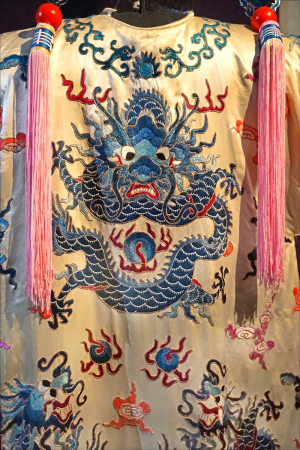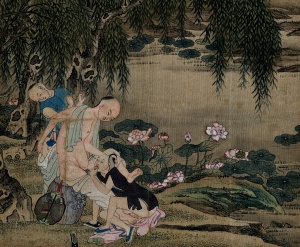(Boylove Documentary Sourcebook) - On the Homoerotic Literary Descriptions of Famous Female-Role Boy Actors of the Beijing Opera in the "Flower Guides" Written by Aficionados in Late Imperial China: Difference between revisions
m Dandelion moved page (Boylove Documentary Sourcebook) - On the Homoerotic Literary Descriptions of Female-Role Boy Actors of the Beijing Opera in the "Flower Guides" of Late Imperial China to (Boylove Documentary Sourcebook) - On the Homoerotic Literary Descriptions of the Qualities of Female-Role Boy Actors of the Beijing Opera in the "Flower Guides" of Late Imperial China |
Added a second note before the excerpt, along with a reference |
||
| (5 intermediate revisions by the same user not shown) | |||
| Line 4: | Line 4: | ||
From <i>[[Homoerotic (dictionary)|Homoerotic]] Sensibilities in Late Imperial China</i> by Wu Cuncun, <i>RoutledgeCurzon/Asian Studies Association of Australia (ASAA) East Asia Series</i> (London; New York: RoutledgeCurzon, 2004). Footnotes omitted. | From <i>[[Homoerotic (dictionary)|Homoerotic]] Sensibilities in Late Imperial China</i> by Wu Cuncun, <i>RoutledgeCurzon/Asian Studies Association of Australia (ASAA) East Asia Series</i> (London; New York: RoutledgeCurzon, 2004). Footnotes omitted. | ||
<b>Note:</b> <i>The multiple </i>huapu<i> ("flower guides", catalogues of </i>dan<i> opera performers) quoted in the excerpt below were written at a time when China followed the East Asian age reckoning, by which people are born at the age of one, i.e. the first year of lifetime using an ordinal numeral (instead of "zero" using a cardinal numeral), and on Chinese New Year or New Year's Day one year is added to their age. Since age is incremented at the beginning of the lunar or solar year, rather than on the anniversary of a birthday, people may be one or two years older in Asian reckoning than in the international age system.</i><ref>https://en.wikipedia.org/wiki/East_Asian_age_reckoning</ref> | <b>Note 1:</b> <i>The multiple </i>huapu<i> ("flower guides", in the sense of catalogues of </i>dan<i> opera performers) quoted in the excerpt below were written at a time when China followed the East Asian age reckoning, by which people are born at the age of one, i.e. the first year of lifetime using an ordinal numeral (instead of "zero" using a cardinal numeral), and on Chinese New Year or New Year's Day one year is added to their age. Since age is incremented at the beginning of the lunar or solar year, rather than on the anniversary of a birthday, people may be one or two years older in Asian reckoning than in the international age system.</i><ref>https://en.wikipedia.org/wiki/East_Asian_age_reckoning</ref> | ||
<b>Note 2:</b> <i>The careers of </i>dan<i> actors were short, lasting from around thirteen to until around eighteen years of age.</i><ref>Wu Cuncun, <i>Homoerotic Sensibilities in Late Imperial China</i>, part of the <i>RoutledgeCurzon/Asian Studies Association of Australia (ASAA) East Asia Series</i>, (London; New York: RoutledgeCurzon, 2004), p. 147.</ref> | |||
<div style="margin:.5em auto; width:95%; min-height:5em; background-color:#F5FAFF; border:3px solid #c9c9ff; padding:1em;"> | <div style="margin:.5em auto; width:95%; min-height:5em; background-color:#F5FAFF; border:3px solid #c9c9ff; padding:1em;"> | ||
Latest revision as of 22:08, 30 June 2021

From Homoerotic Sensibilities in Late Imperial China by Wu Cuncun, RoutledgeCurzon/Asian Studies Association of Australia (ASAA) East Asia Series (London; New York: RoutledgeCurzon, 2004). Footnotes omitted.
Note 1: The multiple huapu ("flower guides", in the sense of catalogues of dan opera performers) quoted in the excerpt below were written at a time when China followed the East Asian age reckoning, by which people are born at the age of one, i.e. the first year of lifetime using an ordinal numeral (instead of "zero" using a cardinal numeral), and on Chinese New Year or New Year's Day one year is added to their age. Since age is incremented at the beginning of the lunar or solar year, rather than on the anniversary of a birthday, people may be one or two years older in Asian reckoning than in the international age system.[1]
Note 2: The careers of dan actors were short, lasting from around thirteen to until around eighteen years of age.[2]
Beyond the feminization of the dan within the traditions of the theatre troupe, audiences also contributed to the aura of feminization through their own discourse of connoisseurship. One of the central concerns of the huapu was to identify exactly which feminine traits each dan displayed both on and off stage. In the Yanlan xiaopu (A small book on the orchids of Yan), the earliest huapu of the Qing dynasty, there are numerous descriptions comparing the listed dan to beautiful young girls, as the following selections from two of the entries attest:
[Golden Orchid-boy] has a fine waist and careful step, a slender neck and modest shoulders, and observing him one is reminded of a gentle maiden. One would never guess it to be the dissimulation of an actor.
[Golden Osmanthus-boy] has a delightfully thin body, with a glowing skin and gentle face, reminding one of a demure girl who waits [for her lover] beside the city wall.
These kinds of descriptions, where the dan stars are poetically compared to women or girls, are abundant throughout later huapu. The following examples are from Fengcheng pinhua ji, Chang’an kanhua ji and Dingnian yusun ji:
There is a junior actor about eleven or twelve, charming and seductive even without flamboyant dresses or accessories. He is as pretty as a female beauty and my heart felt a tender love for him.
Yunqiu, like the Maiden of the Lotus Flower, is peerlessly pretty and bright.
Cuixiang is the most charming boy of the Wu region. The emperor Yang of the Sui dynasty felt the girl flower-arranger Yuan Bao’er was adorable, but I think this boy must supersede her.
Liu Wu’er is an incarnation of the Maiden of the Lotus Flower.
The fashion for feminine boy-actors also meant that the authors of the huapu exaggerated the feminine qualities of the dan, or at least downplayed any signs of masculinity. In Chang’an kanhua ji, Ruizhu Jiushi describes his impressions of a meeting with the boy-actors Cuixia and Cuixiang:
[Cuixia] stands tall and radiant like white jade. He is clearly an impressive young man, but there is also something bashful about him that reminds one of a young maiden…. Of those who have arrived recently only Cuixiang is so delightfully soft. What a perfect girl (shi hao nüzi).
In passages such as this there is clearly a tendency to map the boy-actors’ beauty on to a pre-established template of femininity. As we have seen above, the dan were not necessarily selected exclusively on the basis of signs of femininity, an unblemished appearance being as important as anything else. Training, mimicry and costume were always needed to complete the desired effect. And if these did not succeed entirely, the prevailing sensibility and mood of the times allowed the imagination (and the poet) to preserve the illusion. In compiling their ‘flower guides’ reviewers were bound by the rules of the genre to eradicate, or cover over, any hint of masculinity. The highest praise for dan/xianggong always spoke of their unique femininity, a formula that was so overused as to be far from unique. The slightest feminine air, once exaggerated in the heart of a besotted aficionado, could suddenly bring a boy some fame as a minor celebrity.
The feminization of subaltern males was part of, and contributed to, a wider homoerotic sensibility, a structure of feeling that invested boy-actors with a magical allure that was irresistible to the elite males who supported and enjoyed the fashion. The training and feminization of the boys created a physical illusion, but it also answered a desire and taste that existed in, and was given meaning through, social relations. The magical allure of the dan was just as much a result of their place within the social structure as it was their training: their training and performance defined them as feminized boys, but they also defined them as a site or space for the enactment of the self-indulgent fantasies of the male elites.
The insistent repetition of ‘feminine’ adjectives and categories in the huapu served a double function: ostensibly they were a guide used by men (or groups of men) interested in finding the boys who would most powerfully feed their fantasies, but at another level they were the expression of their authors’ own appreciation of that fantasy world; that is to say, they were a vehicle where the aficionados could gain recognition for their own good taste. The authors of huapu were engaged in a form of connoisseurship where their own good judgement was on exhibition as much as the appearance of the dan they described.

References
- ↑ https://en.wikipedia.org/wiki/East_Asian_age_reckoning
- ↑ Wu Cuncun, Homoerotic Sensibilities in Late Imperial China, part of the RoutledgeCurzon/Asian Studies Association of Australia (ASAA) East Asia Series, (London; New York: RoutledgeCurzon, 2004), p. 147.
See also
- Adult friend (dictionary)
- Age of attraction (dictionary)
- Boylove
- Ephebophilia
- Loved boy (dictionary)
- Minor-attracted person (dictionary)
- Pederasty
- Pedophilia
- Young friend (dictionary)